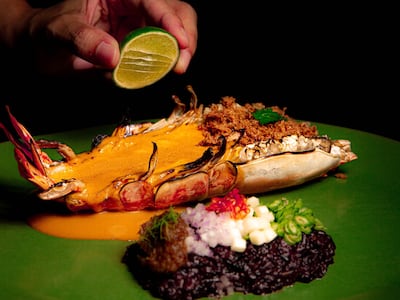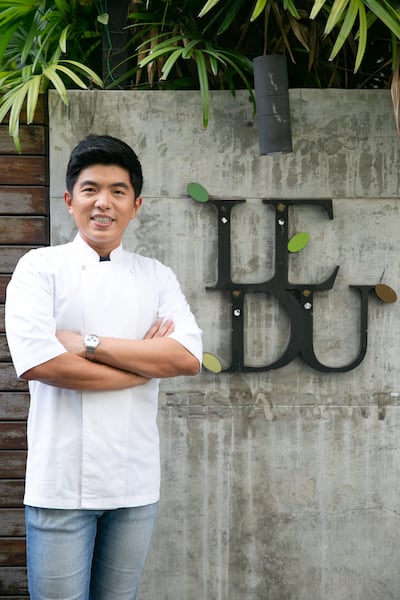Seeking to change the perception that Thailand’s cuisine is dominated only by cheap street outlets, the Michelin-starred Le Du serves Thai food with a modern approach.
When I sit down to dinner with him on a recent visit to Bangkok, chef Thitid “Ton” Tassanakajohn says he applies international techniques to Thai ingredients, in the process whipping up dishes that “look modern, but taste authentic”.
Fitting also is the fact Le Du means “season” in Thai, for chef Ton’s is a menu that changes several times a year depending on what fresh, seasonal produce he can source week to week – all save for one special dish.
Where to sit and what to expect

The restaurant that ranks No 1 on Asia’s 50 Best Restaurants 2023 list is in a narrow, utterly unassuming alleyway in Bangkok’s Bang Rak area.
The only hint at the delicacies that await within is the aesthetically designed signature, with little green buds punctuating each letter – a sign of the fresh greens and other seasonal ingredients that chef Ton prides himself on using.
The restaurant itself is of Lilliputian proportions, with its intimately low ceiling and a series of stunted white columns that quite naturally partition the space, which can seat but 40 at a time. The columns are left plain, save for barely visible abstract branch-like etchings.
All of this serves to keep the focus (at least until the food arrives) on the one wall that’s dominated by a large installation by Korokot. The Thai artist specialises in sinuous designs made from bamboo and gnarled hemp rope, using techniques inspired by kite-making.
The menu
Although the restaurant serves dishes a la carte, it would be remiss not to try the seasonal, six-course tasting menu, with a side order of chef Ton’s signature dish – the river prawn with mountain rice and shrimp paste at 1,200 baht ($34).
My meal starts with a quartet of amuse-bouche, which are unlikely to be the same on any given month or even week, but are a testament to chef Ton’s penchant for melding flavours.
One canape, for instance, offers squid with a combination of Bearnaise sauce and a peanut and chilli dressing. Another is crabmeat and bean sprouts tossed together with garlic, tofu and radish, and topped with a single black crisp that seamlessly combines dehydrated soy sauce, vinegar and sugar in one crunchy, flavourful bite.
Chef Ton’s promise of seasonal ingredients comes through from the first course itself, with the greens and tomatoes sourced from a farm in Chiang Mai; the sea bass coming from the south of Thailand; and the spice mix coming from the north. Taste wise, this offers a burst of freshness in every bite. The greens are young, fresh and crunchy; the sauce is flavourful without being overbearing; while the flaky fish is the star of this dish in terms of taste and heft.
Next up is a banana prawn dish from south-west Thailand, with the crustacean poached in Thai herbs, and served with a garnish of sea grapes, dill and Thai basil, and with a side of beetroot sorbet.
chef and founder, Le Du
Here, the seafood almost takes a back seat, as it is overtaken by the herbaceous greens, sweet sea grapes (my new favourite ingredient) and tangy sorbet, a shining example of chef Ton’s flavour-mixing ways.
One bite of the ocean catfish dish that follows, and I forget all about the prawn that preceded. This is the most succulent seafood meat I have sampled, and I learn the fish is found only in the north-east of Thailand and its taste is down to the fact it lives in mixed waters that makes the flaky fish marvellously tender and tasty.
The umami-amplified tiger prawn is my least favourite dish, perhaps because the strong, lingering taste and smell distracts my palate from the previous dish. This also comes with a spicy-sweet caramel mix and a tart red sauce. It all feels like a lot, save for the rice cake accompaniment, which is a chewy, heart-warming nibble amid the other, rather tumultuous flavours.
The tasting menu ends with a dish that’s at once familiar but foreign: a perfectly pink A5 striploin of Wagyu. The difference is this one’s local, too – and comes, not from Japan, but Sakon Nakhon province in Thailand.
The result? It looks like Wagyu, but does not have the greasy, “beefy” taste my palate associates with the meat. This is not necessarily a bad thing, but the lightness of the steak does take some getting used to. It’s served with beef liver pate, fried noodle and a chilli puree, all of which combine to give it a welcome heaviness and heartiness, and mark a fitting end to a masterful meal.
Standout dish

The ocean catfish and signature river prawn are close competitors, with khao kluk kapi edging out the former only because it’s a year-round item on the Le Du menu.
If you opt for the six-course tasting menu, get this hearty dish to share. The grilled Tapi River prawn comes with two types of black rice and a wholesome sauce made from tom yum kung and prawn head cream. Utterly indulgent.
Chef Ton says: “I believe this river prawn is better than lobster or any other crustacean in the world, which is why it’s always available at Le Du, and is my way of showcasing the integrity of Thai seafood to the world.”
A chat with the chef

Chef Ton is an economics graduate. “Even though it was my grandmum whose cooking inspired me to become a chef, my family was always against the restaurant business. After graduating, I worked in a bank for exactly one month and realised this is not for me. So I told my mom, I am going to New York [to study at The Culinary Institute of America]; I hope you accept it, but I am going anyway.”
Having worked at Michelin-starred restaurants including Eleven Madison Park and Jean Georges, Ton returned to his native Bangkok and launched Le Du a decade ago. Appreciation and accolades soon followed. Before winning top honours on Asia’s 50 Best Restaurants list, Le Du went from spot 37 in 2017 to fourth place last year. The restaurant has also retained its Michelin star since 2018.
As the chef notes: “My family are happy now!”
Price point and contact details
The six-course tasting menu costs from 4,500 baht, with an added six-glass kombucha pairing for 1,000 baht. A four-course menu is available for 3,900 baht.
Le Du is open for lunch and dinner every day except Sunday. Reservations can be made at www.ledubkk.com.
This review was conducted at the invitation of the restaurant





